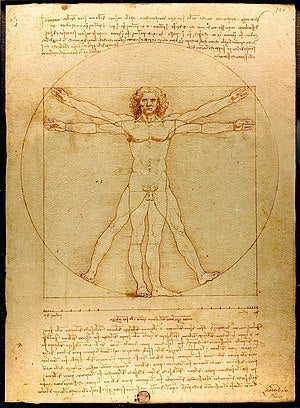One thing that mathematicians frequently say that may come as a surprise is that math is a highly creative enterprise. On paper, it may sometimes look dry and technical, but the thinking involved in doing math calls on the creative muse.
It’s no wonder that so many mathematicians are interested in art, and so many artists are interested in math. Visual artists and painters, especially, draw upon mathematical concepts in their works, and some of the most famous works of art have mathematical elements. Architecture, sculpture, monuments and other forms of art also work with math in creative ways. There is even a special academic publication dealing with the subject, the Journal of Mathematics and the Arts.
Join us as we explore the top 5 expressions of math in art.
1. Vitruvian Man by Leonardo da Vinci. This extremely famous sketch is a rendering of the proportions of the male human body. It is an example of the Renaissance obsession with the artistic representation of mathematics. Da Vinci himself is what is called a “polymath,” which is someone interested in drawing from diverse fields to solve problems.

2. Drip painting method by Jackson Pollock. The contemporary painter Jackson Pollock is known for his chaotic canvases that have splatters and drips of different coloured paint. Art historians have pointed out, and mathematicians have echoed, the way that his works are forms of fractal geometry, seemingly random but having underlying symmetries. However, there is also a dispute among mathematicians about whether Pollock's works are true expressions of fractals.

3. Geometry in art by Salvador Dali. The absurdist painter Salvador Dali was obsessed with geometric shapes. Many of his works have cones, spheres, rectangles, triangles and various other shapes. Dali is said to have begun every work of art with a geometric shape, and then built creatively based on his intuition of where to go next.

4. Bridget Riley’s stripe paintings. The British painter creates art that sometimes appears like optical illusions. Theorists have shown that Riley’s work draws on concepts of complex patterns and entropy in the construction of the art. Her art is said to challenge straightforward notions of meaning and perspective, but to do so using straightforward systems of lines and geographic space on the canvas.

5. M. C. Escher’s surreal artistic spaces. Many will recognize Escher’s endless staircases and scenes that challenge easy understanding. Mathematicians have pointed out that Escher’s art often deals with hyperbolic geometry. The artist was friends with and even worked on some of the concepts for his art with the Canadian mathematician and geometer Harold Scott MacDonald Coxeter.

By the Numbers is a weekly series that reflects on the lighter side of student life, research and innovation in the Faculty of Mathematics at the University of Waterloo. Stay tuned to this space for the next installment.